
Nakskov Church (Danish : Sankt Nikolai Kirke) is the largest church in Nakskov on the west coast of the Danish island of Lolland. As Nakskov was mentioned in Valdemar's Census Book in the 13th century, the church probably dates to the same period.

Nakskov Church (Danish : Sankt Nikolai Kirke) is the largest church in Nakskov on the west coast of the Danish island of Lolland. As Nakskov was mentioned in Valdemar's Census Book in the 13th century, the church probably dates to the same period.
Remains of a wooden church from c. 1000 were unearthed in the 1950s. [1] It was replaced by a brick church dedicated to Saint Nicholas which is first mentioned in 1398 although its oldest sections probably date from the early 13th century. It was completed in the second half of the 17th century. Major repairs were carried out in 1746 but further work proved necessary in 1825. Before the Danish Reformation, the church had a series of chapels and altars, each connected with the craftsmen's guilds in the town. Much of the documentation was destroyed when the Lübeckers plundered Nakskov in 1510. [2]
Built of light red brick, the original chancel and nave were in the Romanesque style. Parts of these remain in the Gothic additions from the first half of the 15th century. Major extensions were added to both east and west, resulting in aisles on either side of the nave which virtually encapsulated the older construction. A large tower was also built at the west end of the former nave at the beginning of the 15th century. In the mid-17th century, after a period of some 200 years without further construction work, Gothic additions were completed. The Romanesque chancel was demolished while rectangular arches were added in the former walls. The spire which was repeatedly damaged by lightning was finally redesigned by H.C. Glahn in 1906. [2]

The carved altarpiece in the auricular style from 1656 is the work of Anders Mortensen from Odense. The central painting of the Last Supper (which contains an image of Nakskov Church in the background) is topped by depictions of the Crucifixion and Christ's removal from the cross. There are also figures of the Evangelists and the Apostles, Christ Resurrected and also of Moses and Aaron. [3] [2] The pulpit, also in the Baroque auricular style, was completed by Jørgen Ringnis in 1630. It was presented to the church by Mayor Thyge Sørensen whose portrait, and that of his wife, have been included in the pulpit's decorations which also include the 12 apostles. Ringnis also designed the gallery (1631) with figures of the apostles which now stands below the organ loft. [4] The organ was built by Johan Lorentz in 1648 and restored in 1968. On that occasion, Paul-Gerhard Andersen took pains to restore the organ's Baroque housing by Søren Ibsen. [5]

Væggerløse Church is a Romanesque church in the village of Væggerløse, 7 kilometres (4.3 mi) south of Nykøbing on the Danish island of Falster. Its early 16th century frescos depict the Supper at Emmaus.
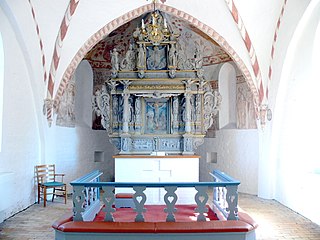
Jørgen Ringnis, also known as "Jørgen Billedsnider", was a Danish woodcarver. He created a number of altarpieces and pulpits in Danish churches, especially on the islands of Lolland and Falster.

Stubbekøbing Church is located in Stubbekøbing some 18 km (11 mi) northeast of Nørre Alslev on the Danish island of Falster. The basilical nave was built of limestone in the Late Romanesque period. Choir and tower are of brick, the choir built in Early Gothic style, tower and the northern chapels in the 15th century in Late Gothic style. In addition to its Renaissance altarpiece and pulpit, it has a variety of old frescos and wall decorations (1300–1500).

Brarup Church is located in the village of Brarup some 5 km (3.1 mi) southwest of Nørre Alslev on the Danish island of Falster. The Late Romanesque church has frescos from various periods including several by the Brarup Master and his workshop from the early 16th century.

Kippinge Church stands alone, midway between Vester Kippinge and Øster Kippinge in northwestern Falster, Denmark. It is west of Redslev wood. Thanks to three reputed miracles, the Early Gothic church attracted many pilgrims until the end of the 19th century. It is known for its rich Renaissance furnishings and its frescos from the mid-14th century.

Eskilstrup Church is a church in Eskilstrup, Denmark. The church dates from the 12th century and was built in the Romanesque style. In accordance with a local tradition, it is painted red. It is best known for its frescos, said to be Denmark's oldest.

Toreby Church is the parish church of Toreby on the Danish island of Lolland. It is an unusually large red-brick Romanesque building, the nave and chancel having been extended in the Gothic period with a sacristy and lateral aisle. The tower is late Romanesque. There are frescos from c. 1400 in the sacristy. The carved pulpit (1645) is the work of Jørgen Ringnis.

Østofte Church, located in the village of Nørreballe on the Danish island of Lolland, was built in the 14th century. The Romanesque apse, chancel and nave formed the original building while the tower and porch were added in the Late-Gothic period and the north wing was completed in 1656.
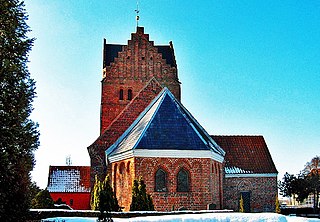
Stokkemarke Church is located in the village of Stokkemarke some 11 km (6.8 mi) northwest of Maribo on the Danish island of Lolland. Dating from the middle of the 13th century it was built in the Romanesque style with later additions in the Gothic period.
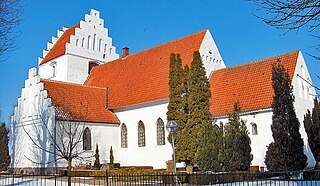
Hunseby Church is located in the village of Hunseby some 3 km north of Maribo on the Danish island of Lolland. Built in the middle of the 12th century, the church has a Romanesque chancel and nave and a Gothic tower.

Sandby Church is located in the village of Sandby some 7 km northwest of Nakskov on the Danish island of Lolland. Dating from the middle of the 13th century, the church has a Romanesque chancel and nave and a Late Gothic tower.

Sandby is a village located some 7 km (4.3 mi) northwest of Nakskov on the Danish island of Lolland. It belongs to Lolland Municipality in Region Sjælland. As of 2024, it has a population of 348.

Halsted Church stands in the little village of Halsted some 6 km east of Nakskov on the Danish island of Lolland. Dating from the second half of the 12th century, the church has a Romanesque chancel and nave, a large burial chapel from 1636 and a tower from 1877. The church was closely associated with Halsted Priory, which has not survived.

Birket Church is located south of the little village of Birket, some 14 km (8.7 mi) northeast of Nakskov on the Danish island of Lolland. Its chancel was originally the nave of the brick Gothic church built in 1350. The bell tower, which stands apart from the church, is believed to be Denmark's oldest standing wooden structure.

Avnede Church is a Gothic church located some 7 km (4.3 mi) southeast of Nakskov on the Danish island of Lolland. Frescos discovered on the chancel arch during repairs in 2009 are now being restored by the National Museum.
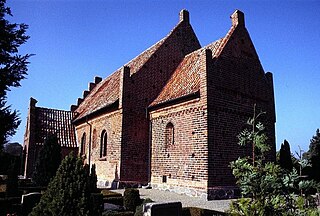
Olstrup Church is a Romanesque church in open country west of Errindlev in the south of the Danish island of Lolland. There are 16th-century frescos of the Last Judgment on the chancel arch with Christ sitting on a rainbow.

Dannemare Church is a Neo-Romanesque church in the village of Dannemare, some 12 km (7.5 mi) south of Nakskov on the Danish island of Lolland. Built in 1897, it replaced the earlier Romanesque church which burnt down in 1897.

Tillitse Church is a Romanesque building west of the village of Dannemare, some 8 km (5.0 mi) south of Nakskov on the Danish island of Lolland. Built of red brick in the first half of the 13th century, it has an intricately carved auricular altarpiece created by Jørgen Ringnis in 1642. An 11th-century runestone stands outside the church entrance.
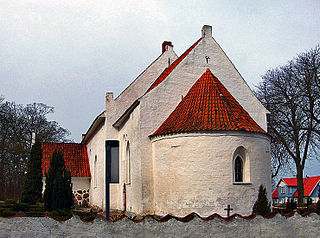
Arninge Church is a Late Romanesque church in the little village of Arninge, some 8 km (5.0 mi) south of Nakskov on the Danish island of Lolland. Built of red brick in the 13th century, it has an intricately carved auricular altarpiece created by Henrik Werner in 1644.

Gloslunde Church is a Romanesque church east of Dannemare, some 13 km (8.1 mi) southeast of Nakskov on the Danish island of Lolland. Now whitewashed, it was built of red brick in the 13th century. The heritage listed Gloslunde Rectory is located next to the church.